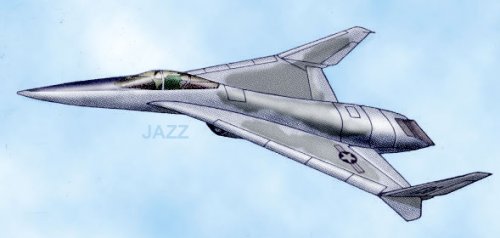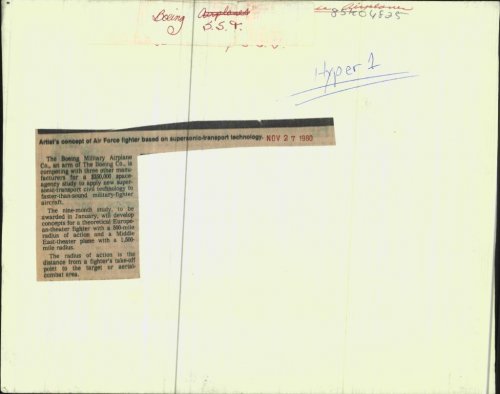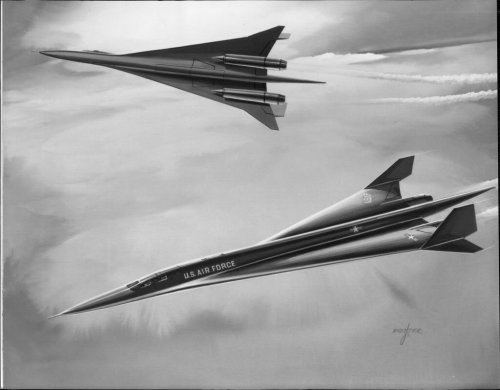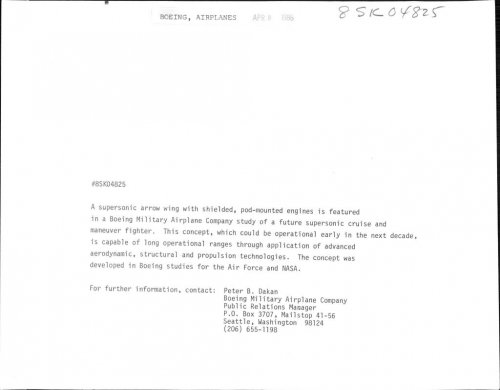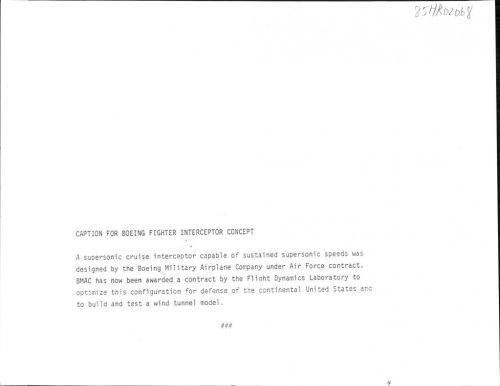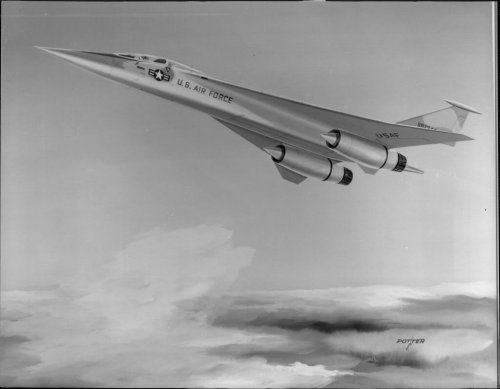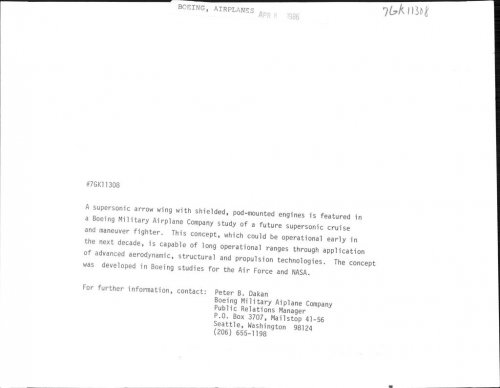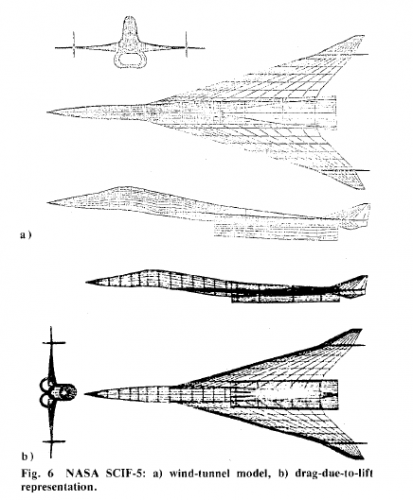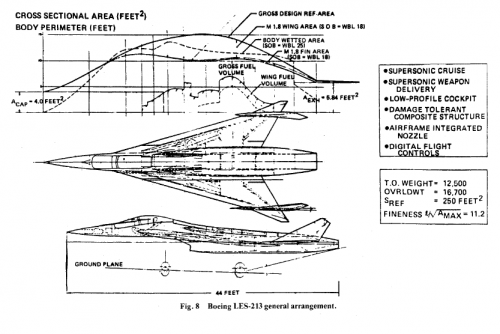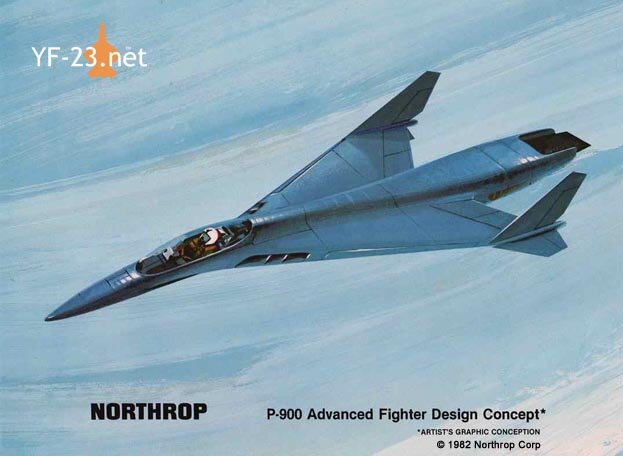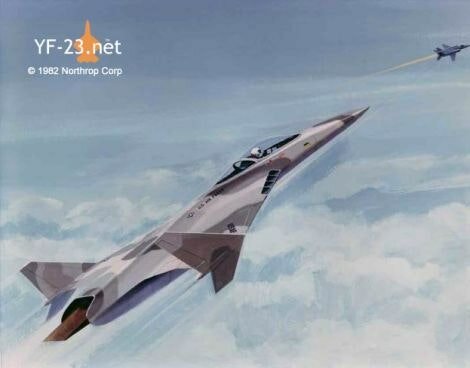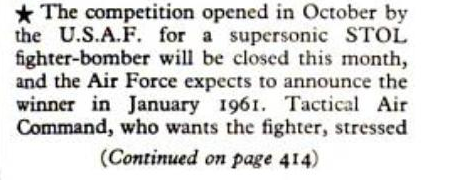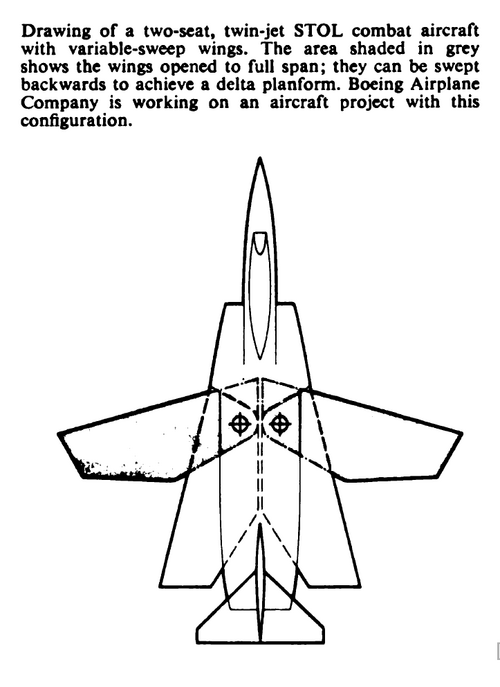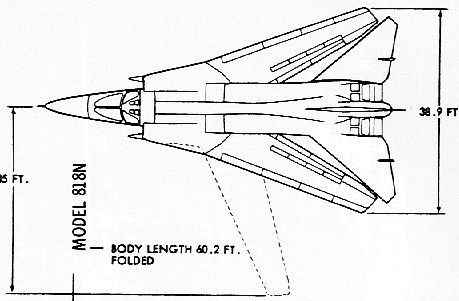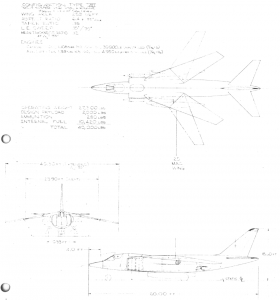You are using an out of date browser. It may not display this or other websites correctly.
You should upgrade or use an alternative browser.
You should upgrade or use an alternative browser.
Misc Boeing Fighter Projects
- Thread starter JAZZ
- Start date
- Joined
- 25 July 2007
- Messages
- 4,167
- Reaction score
- 3,835
amsci,
The vortex flaps are the leading edge devices visible in the drawing. Vortex flaps create low pressure lift by producing a stable vortex above the flap.
From what I could glean, the XB-70's VG wingtips were designed to take advantage of lift compression. In other words, the folded-down tips contained the shock wave that forms on the wing's underside at high speeds and then the Valkyrie could ride the lift generated by the rising pressure.
The vortex flaps are the leading edge devices visible in the drawing. Vortex flaps create low pressure lift by producing a stable vortex above the flap.
From what I could glean, the XB-70's VG wingtips were designed to take advantage of lift compression. In other words, the folded-down tips contained the shock wave that forms on the wing's underside at high speeds and then the Valkyrie could ride the lift generated by the rising pressure.
- Joined
- 17 October 2006
- Messages
- 2,354
- Reaction score
- 988
Don't forget the LE devices on the X-32.
- Joined
- 2 August 2006
- Messages
- 3,206
- Reaction score
- 1,322
Would like to know what a vortex flap is myself, could it be flaps on the wingtips? IIRC, the X-70 Valkyrie had wingtip flaps for supersonic cruise.
Look at pics of the X-32 in landing configuration and you'll see vortex flaps on the upper leading edge of the wing. They work in the same manner that strakes/leading edge root extensions operate, only they're retractable and probably operate at lower alpha, depending on the requirements.
A
avatar
Guest
okay .. might sound over speculative or even silly ... but could this be the starting point for Boeing's so called sixth generation fighter?
- Joined
- 1 April 2006
- Messages
- 11,053
- Reaction score
- 8,512
No chance. It's very old stuff from 80s.avatar said:okay .. might sound over speculative or even silly ... but could this be the starting point for Boeing's so called sixth generation fighter?
A
avatar
Guest
thanks man . I see ... but have you looked at the pdf posted by lantinian in the aerospce thread?
Artist's impression of Boeing European Theater fighter concept found on eBay.
Source:
Source:
Attachments
Attachments
Attachments
Attachments
- Joined
- 26 May 2006
- Messages
- 33,572
- Reaction score
- 13,701
Hi,
and here is a file about this Boeing Fighter Project,and they called it LES-213,and the
initial vehicle utilized a wing planform similar to the NASA SCAT-15F is called LES-210,
also the NASA SCIF-4 and SCIF-5.
Aerodynamic Analysis of Supersonic Aircraft with Subsonic Leading Edges
http://arc.aiaa.org/doi/abs/10.2514/3.58378?journalCode=ja
and here is a file about this Boeing Fighter Project,and they called it LES-213,and the
initial vehicle utilized a wing planform similar to the NASA SCAT-15F is called LES-210,
also the NASA SCIF-4 and SCIF-5.
Aerodynamic Analysis of Supersonic Aircraft with Subsonic Leading Edges
http://arc.aiaa.org/doi/abs/10.2514/3.58378?journalCode=ja
Attachments
- Joined
- 2 August 2006
- Messages
- 3,206
- Reaction score
- 1,322
Does anyone know if that was work by Bud Nelson while he was at Boeing or if they were designed after he went to Northrop? The first design above sure looks like the iteration between his micro-fighter for the 747 carrier and his P-900 at Northrop.
- Joined
- 26 May 2006
- Messages
- 33,572
- Reaction score
- 13,701
Re: Boeing Unknown Fighter
Hi,
who know what was this Boeing STOL,V/STOL or VTOL attack fighter Project of 1964 ?.
Hi,
who know what was this Boeing STOL,V/STOL or VTOL attack fighter Project of 1964 ?.
HIGH PERFORMANCE GENERAL PURPOSE ATTACK AIRCRAFT STUDY. CONFIGURATION ANALYSIS
Comparative airplane concepts designed to accomplish pure attack or multimission attack/fighter missions are presented for STOL, V/STOL, or VTOL takeoff and landing modes. A cursory analysis of the operating characteristics and costs of the more interesting configurations is included. It is...
apps.dtic.mil
blackkite
Don't laugh, don't cry, don't even curse, but.....
- Joined
- 31 May 2007
- Messages
- 8,597
- Reaction score
- 6,844
Hi! Northrop P-900.Does anyone know if that was work by Bud Nelson while he was at Boeing or if they were designed after he went to Northrop? The first design above sure looks like the iteration between his micro-fighter for the 747 carrier and his P-900 at Northrop.
Attachments
- Joined
- 11 March 2012
- Messages
- 3,122
- Reaction score
- 2,962
Remember that Withold Kasper worked for Boeing after he left Poland and Canada. Leading edge vortex flaps were a prominent part of his BKB sailplane. He also installed a vortex flap near the trailing edge to generate a second vortex.amsci,
The vortex flaps are the leading edge devices visible in the drawing. Vortex flaps create low pressure lift by producing a stable vortex above the flap.
...
The difference was that Kasper hinged his leading edge vortex flaps at their leading edge. Kasper hinged his vortex flaps upwards to encourage a span-wise row of dead airspace. The dead airspace was supposed to generate a vortex that would stabilize low pressure airflow.
Meanwhile, this proposal, F-18, Tejas, etc hinge their leading edge flaps at the trailing edge to increase wing camber. F-8, etc. also use trailing edge flaps to increase camber and lift for landing.
Last edited:
- Joined
- 12 May 2008
- Messages
- 226
- Reaction score
- 444
This is the thread on the work that Bud Nelson did at Northrop.
Avimimus
ACCESS: Top Secret
- Joined
- 15 December 2007
- Messages
- 2,277
- Reaction score
- 589
Hi,
and here is a file about this Boeing Fighter Project,and they called it LES-213,and the
initial vehicle utilized a wing planform similar to the NASA SCAT-15F is called LES-210,
also the NASA SCIF-4 and SCIF-5.
Aerodynamic Analysis of Supersonic Aircraft with Subsonic Leading Edges
http://arc.aiaa.org/doi/abs/10.2514/3.58378?journalCode=ja
Thanks! It is quite interesting to see this in a twin-engined concept.
- Joined
- 26 May 2006
- Messages
- 33,572
- Reaction score
- 13,701
From Air Pictorial 1960,
what was this STOL Fighter-Bomber ?.
Obviously the Boeing was the winner of this competition,and may it got the Model-8XX,but never
heard about this contest,who can help ?.
- Joined
- 26 May 2006
- Messages
- 33,572
- Reaction score
- 13,701
From Air Pictorial 1960,
what was this STOL Fighter-Bomber ?.
From Interavia 1961,
here it's,as I think.
Attachments
- Joined
- 27 December 2005
- Messages
- 16,924
- Reaction score
- 21,798
Its a generic illustration of the "swing wing" concept by the magazine.
- Joined
- 27 December 2005
- Messages
- 16,924
- Reaction score
- 21,798
A design to SOR-183 most likely. Early on, VTOL/STOL was part of the pre-TFX studies.From Air Pictorial 1960,
what was this STOL Fighter-Bomber ?.
- Joined
- 26 May 2006
- Messages
- 33,572
- Reaction score
- 13,701
A design to SOR-183 most likely. Early on, VTOL/STOL was part of the pre-TFX studies.
Can I suggest something ?,may it looks like Boeing Model-837-319 ?.
Attachments
Similar threads
-
ASD Preliminary Designs in Splendid Vision, Unswerving Purpose
- Started by XP67_Moonbat
- Replies: 16
-
McDonnell Douglas & Boeing BWB projects
- Started by flateric
- Replies: 109
-
USAF Project 'AERIE' The ultimate stand-off interceptor?
- Started by Pioneer
- Replies: 26
-
CX-HLS (Cargo Experimental, Heavy Logistic Support) designs & derivatives
- Started by Antonio
- Replies: 208
-
1950s Lockheed Nuclear Powered bomber studies
- Started by Stargazer
- Replies: 27

